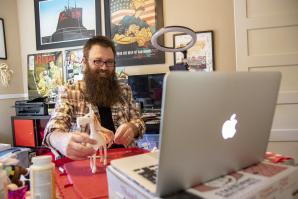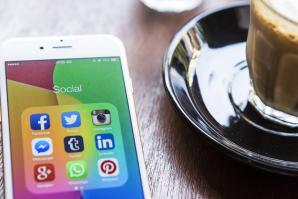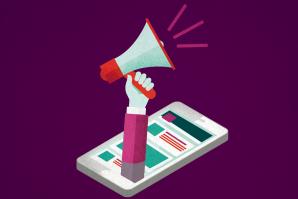It was supposed to be a vacation. Last August, Ginger O’Brien took a week off and flew 3,000 miles to see family, including a new cousin she found through a DNA test. She doesn’t usually go east for vacations — in fact, O’Brien can’t recall the last time she took a full day off. Even on this trip, she admits to working every morning. As controller for Digital Deployment, a web development company in Sacramento, O’Brien manages accounting records and worries what will happen if she completely unplugs.
“Part of it is I don’t want to get buried in work, part of it is a feeling of being disconnected,” she says. “I have this fear that I might miss something important or let something fall through the cracks, something I didn’t take care of before I left.”
This is a story about technology addiction. It is about 1,800 words, which will take around 14 minutes to read without distractions. The average American checks their phone every 10 minutes, according to research from global tech company Asurion in 2019. If you finish reading this without checking your phone, congratulations. If you cannot, you might be part of the majority in a 2018 Asurion survey who listed their phone as a top-three life essential, along with food and water. Even on vacation, research shows, people cling to mobile devices like life jackets in choppy waters. There is a word for the fear of being without a mobile device or being out of cellular phone contact: nomophobia (no mobile phone phobia).
But this is the digital age, after all. Modern technology helps people communicate faster and stay connected and meet new relatives all over the globe. With teleconferencing, email, e-commerce and social media, the internet makes it possible for many people to work virtually. However, being “always online” comes at a cost. According to scientists, technology addiction can make brains look similar to those affected by heroin or gambling addictions.
O’Brien wouldn’t say she is addicted to technology; she limits her time and stays off the computer after work hours. But this spring, with the COVID-19 pandemic forcing people to self-isolate, O’Brien admits to being online a lot more than before.
“I don’t think that’s because I’m addicted as much as trying to connect to the world,” she says.
Your Brain on Dopamine
From the brain’s perspective, it wants to feel good. Cravings come in different forms, such as food, sex or winning the lottery, and release a pleasurable chemical, a neurotransmitter called dopamine. That same chemical is released when trying to beat a level in a video game, hearing a notification ding or seeing who liked your Instagram post. Your brain says, “That felt good. I want more!”
But brains under the age of 25 are still developing. External stimuli — such as excessive screen time — in a developing brain can alter its wiring, says Michael G. Chez, pediatric neurologist and regional director of pediatric neurology and pediatric research at Sutter Health. This is especially risky for toddlers, he says. “We all did blocks, tying beads, putting different shapes in holes,” Chez says. “Those infant toys are very good as opposed to using screens to match shapes.”
Studies show that early and prolonged exposure to electronic screens can lead to language delay, short attention span and hyperactivity. Chez says excessive screen time also leads to less interest playing outside, crawling or using hands to build things. Essentially, on-screen activities can rewire the way the brain interprets the three-dimensional environment of the real world. But Chez notes positive things about video games, especially for the aging brain. Research shows video games may help seniors improve cognitive function, memory and the ability to multitask. To that end, he says, technology is a tool that needs to be used responsibly.
“Where do you need it for work, and where does it become an obsession?” he asks. “We might need to put warnings on things. It is a health risk.”
If your family has a history of other types of addictions — alcoholism, drugs, smoking, food — you’re more at risk of getting addicted to technology, according to Peter Yellowlees, chief wellness officer at UC Davis Health and a psychiatry and behavioral sciences professor at UC Davis. “Most people can put their phone down and be in the moment,” he says. “But there is a group of people who tend to get overinvolved. They’re the people you want to be careful about.”
Yellowlees has had many high school and college students referred to him for spending too much time online, typically on multiplayer video games. Is there trouble at home? Are they hiding from something? These are the types of questions Yellowlees explores in his sessions. Reasons for escaping into a virtual world may vary, but he sees the same patterns over and over.
“If you give them unlimited access, it will be harmful to them,” he says. “They’re not sleeping, up too late, tired, which affects schoolwork, and they feel worse about themselves, self-esteem goes down, they hide away online — you can see a cycle developing.”
In these cases, their whole social experience is online. In recent years, reports have linked smartphone addiction and social media to declines in social skills. But a new study rejects that argument after comparing the youngest generation to the previous one. Researchers found similar ratings in self-control and no drop in their ability to make and keep friends. But according to Yellowlees, even though his patients typically refer to their online relationships as friendships, these are not really friendships. “I’ve seen people who are literally online 12-16 hours a day,” he says. “They’re essentially not living in the same world as the rest of us.”
Point System
The world of gaming, in many ways, mirrors the world of social media, urging users to participate and stay engaged to achieve mastery, says Mark Otero, a wunderkind of the Sacramento gaming scene who founded online gaming company KlickNation (acquired by EA in 2011).
“In games, people aspire to achieve mastery,” he says. “The game stops being fun once you achieve mastery. It’s the same reason we stop playing tic-tac-toe.”
For most successful online games, he says, a team of data scientists called product managers fine-tune the games’ engagement. They look for patterns, and when they find them, they create ways to make the game more fun to keep players coming back. “The most successful games are the most addictive games,” says Otero, who has since left the gaming world and now heads Sacramento-based hedge fund Alice Capital.
In 2014, entrepreneurs Mitch Gardner and Rob Richardson launched a mobile app to incentivize students to stay off their phones in class. Pocket Points tracks how long the phone is asleep and tallies points, which can be redeemed for discounts and deals at local businesses and online. In schools, teachers can offer unique rewards as prizes, such as dropping a student’s lowest test score or giving out a homework pass. Every college and high school in the country has the ability to use Pocket Points, says Gardner, cofounder and chief operating officer of the Chico-based business, adding that it recently went live in middle schools too.
“We interviewed thousands of high school students, parents and teachers,” Gardner says. “Teachers all say kids are addicted to phones. Students say the parents are just as addicted. There’s some contradictions and hypocrisy going on.”
In March, Pocket Points for families was unveiled to help decrease screen time as a unit. For example, if there are four people in the family with a goal to stay under eight hours a day, the reward might be something like a movie night or pizza for dinner, Gardner says. As someone who runs an app business, Gardner praises some aspects of modern technology, such as the ease of starting a business without much equipment. He also appreciates there seems to be less argument about the reality of technology addiction.
“Technology addiction is not this debate as much anymore,” Gardner says. “Now it’s like, ‘Yep, it’s a thing. What do we do about it?’”
Digital Deployment, which provides web services to companies in the Sacramento region, including Comstock’s, has 20 employees who have an average age of 37. With unlimited vacations and flexible work hours, constant availability can lead to “poor notification hygiene,” says CEO Mac Clemmens, a member of Comstock’s Editorial Advisory Board. Once a year, he has his team commit to one “unplugged week.” No phones, no checking work emails, no meetings. This “digital detox” benefits the employee and also helps the team know that they can manage without being constantly digitally connected. But stepping away can be a struggle.
“Usually, it’s the high performers that have the hardest time,” Clemmens says. “They’re so productive, they don’t want to bother anybody. But this team-player mentality causes them to burn out.”
To counteract this, he set up two channels to distinguish urgent and nonurgent messages. Team members reach each other through a protected channel, but no notifications come after work hours. Recently, he had a conversation with a stressed staff member and devised a plan to turn off email at 6 p.m., putting it in do-not-disturb mode.
“What we’re seeing is the advent of people creating their own boundaries,” Clemmens says. “When they left the office (before smart devices were by our side), they got a break. Because they don’t have that built in, they have to create that boundary for themselves artificially in order to stay balanced.”
Future Tense
The need for boundaries is more vital than ever. In the throes of the coronavirus crisis, people are forced to spend even more time with technology. This is uncharted territory, so the effect of this pandemic on tech addiction remains to be seen.
“We’ve never had a multibillion-person social experiment where this has happened,” says Oleg Kaganovich, a strategic operations executive, startup investor and a member of Comstock’s Editorial Advisory Board. “I think it will take time to see what the implications are. But this is absolutely going to make it harder for some to create healthy boundaries with their technology.”
Scientists say most people need social interaction and human connection. But the call for social distancing makes online social networks more attractive, even necessary. Therein lies the paradox: The same technologies that people were advised to take breaks from to instead connect in the real world are now an essential source to connect to the real world. Not even just for socializing and entertainment, but for making a living through remote work or job hunting.
According to Kaganovich, companies with an objective to help people manage relationships will have a bigger role. “While we’re depending on technology to survive, get through this and cope, we will also see new forms of innovation,” he says. “Times of crisis usually end up being a forcing function for products and services that no one would have thought of prior to.”
As Kaganovich points out, some of these products and services would likely address those moments when people are cut off from one another and help maintain a healthy state of mind.
—
Get feature stories like this delivered directly to your inbox: Subscribe to the Comstock’s newsletter today.
Recommended For You

Photo Essay: The Arts in Isolation
How Sacramento-area artists and art businesses are creating content and engaging with the community during the pandemic
Many organizations and artists around the Capital Region, including dancers, musicians and comedians, are getting creative with technology to continue sharing their work.

Don’t Wait to Create Social Media Guidelines
One misstep can spell disaster for your business
Social media is like quicksand. From afar it looks innocent, but one misstep posting the wrong image or making an improper comment can sink your reputation faster than you thought possible. Additionally, while social media can be a powerful tool to reach clients, get media attention and share promotions with your audience, managing it all can be time consuming.

Dilemma of the Month: Speaking Freely on Social Media
A client recently threatened to quit working with us after seeing politically-charged posts she deemed offensive on one of my account manager’s social media accounts. I’ve asked the employee not to let this happen again, but he countered that we have no policy in place (which is true), and furthermore, these are his personal accounts and he is entitled to free speech. How can I deal with this situation?

3 Social Media Tips for Your College-Bound Teen
Start networking early by leveraging online tools
Try these three strategies to help teenagers use their social media platforms to better prepare for college.




